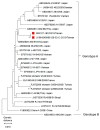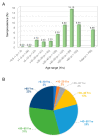Low Seroprevalence of Aichi Virus Infection in Taiwan
- PMID: 34063639
- PMCID: PMC8147638
- DOI: 10.3390/pathogens10050553
Low Seroprevalence of Aichi Virus Infection in Taiwan
Abstract
Aichi virus (AiV) belongs to the genus Kobuvirus of the family Picornaviridae; it is a single-stranded positive-sense RNA virus without an envelope. AiV causes acute gastroenteritis, abdominal pain, nausea, vomiting, and fever. Low incidence and high seroprevalence of AiV infections have been reported in several regions of the world; however, little was known on the prevalence of AiV infections in Taiwan. This study described the first two cases of AiV infection and analyzed AiV seroprevalence in Taiwan. A total of 700 sera were collected from a single hospital in southern Taiwan. The neutralization assay was employed to assess AiV neutralization antibodies in the serum. The test identified 48 positive cases, with a seroprevalence of 6.86%. Results also showed a gradual increase in AiV seroprevalence rate with age. Compared with other countries, Taiwan had a relatively low AiV seroprevalence, suggesting a low incidence of or sporadic AiV infections.
Keywords: Aichi virus; Taiwan; seroprevalence.
Conflict of interest statement
The authors declare no conflict of interest.
Figures


Similar articles
-
A Comprehensive Review on Human Aichi Virus.Virol Sin. 2020 Oct;35(5):501-516. doi: 10.1007/s12250-020-00222-5. Epub 2020 Apr 27. Virol Sin. 2020. PMID: 32342286 Free PMC article. Review.
-
Detection of Aichi virus with antibody targeting of conserved viral protein 1 epitope.Appl Microbiol Biotechnol. 2013 Oct;97(19):8529-36. doi: 10.1007/s00253-012-4644-5. Epub 2013 Jan 11. Appl Microbiol Biotechnol. 2013. PMID: 23306637
-
Global epidemiology, genotype distribution and coinfection rate of Human Aichi virus: A systematic review.J Infect Chemother. 2025 Jan;31(1):102523. doi: 10.1016/j.jiac.2024.09.012. Epub 2024 Sep 16. J Infect Chemother. 2025. PMID: 39293717
-
Structure of Aichi Virus 1 and Its Empty Particle: Clues to Kobuvirus Genome Release Mechanism.J Virol. 2016 Nov 14;90(23):10800-10810. doi: 10.1128/JVI.01601-16. Print 2016 Dec 1. J Virol. 2016. PMID: 27681122 Free PMC article.
-
Aichi virus infection in elderly people in Sweden.Arch Virol. 2012 Jul;157(7):1365-9. doi: 10.1007/s00705-012-1296-9. Epub 2012 Mar 31. Arch Virol. 2012. PMID: 22466255
References
-
- Yamashita T., Sakae K., Tsuzuki H., Suzuki Y., Ishikawa N., Takeda N., Miyamura T., Yamazaki S. Complete nucleotide sequence and genetic organization of Aichi virus, a distinct member of the Picornaviridae associated with acute gastroenteritis in humans. J. Virol. 1998;72:8408–8412. doi: 10.1128/JVI.72.10.8408-8412.1998. - DOI - PMC - PubMed
-
- Ambert-Balay K., Lorrot M., Bon F., Giraudon H., Kaplon J., Wolfer M., Lebon P., Gendrel D., Pothier P. Prevalence and genetic diversity of Aichi virus strains in stool samples from community and hospitalized patients. J. Clin. Microbiol. 2008;46:1252–1258. doi: 10.1128/JCM.02140-07. - DOI - PMC - PubMed
Grants and funding
LinkOut - more resources
Full Text Sources

